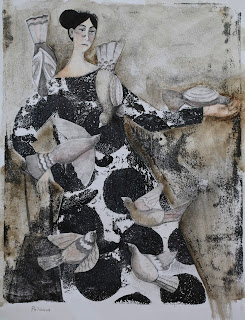First, the prints, and then I`ll give you a lowdown on the gelli plate itself. These are eight of what I`m calling "altered monotypes," or simply monotype and mixed media. Size is approximately A4 paper. I printed about another 15 sheets in the same session, and although I wasn`t so happy with those I was able to use some as collage, and have kept the leftovers for future use. I paint like I cook: always reinvent your leftovers!
I started by printing several layers of different colours and textures and patterns, and then used my own handcut paper stencils. They have all been embellished with painting, collage, free machine embroidery, etc. to create unique one-off pieces, mostly centred around female figures.
mamá
redhead
hen
swan
stood up
remembrance
paloma
árbol
The disadvantages are:
1.They are, I suppose, a little expensive: this one cost me £30, but I think in the long run it is worth it. It will pay itself back quickly.
2. Also, because they are soft, they could be easily scored or damaged, and that would leave a permanent mark on every future print you take.
3. You are limited to size. I think there are now 3 sizes: a square one, 6 x 6 inches, which for me was a little small, the one I purchased, 8 x 10 inches, and now a new larger one, 12 x 14 inches.
4. This is an American product, and there are few stockists in the UK. Here are the ones I could find:
http://www.thestampattic.co.uk/gelli.htm
http://www.claritystamp.co.uk/Gelli-Arts
http://www.thecraftbarn.co.uk/product.
If you are already familiar with my figurative/naive/folk art /renaissance style artwork (it`s been called all of those and everywhere inbetween), you`ll know that I love to use collage in some of my mixed media pieces. Often I use old magazines and catalogues, but lately I`ve been making my own, using my handcarved stamps, etc. So I thought the gelli plate would be great for making my own collage papers, and I wasn`t disappointed. It`s also very quick, and brilliant for using papers and fabrics, etc. with texture - I find this more difficult on perspex. On the gelli surface they adhere much better. It`s also really easy to clean up and best of all, you can easily make a whole stash of papers in one session, and since they recommend you use acrylics, they dry quickly for immediate use.
One thing I find strange is that they are mostly used by crafters. That in itself, isn`t strange. My question is, why don`t more artists/printmakers use them too? They have great potential for both disciplines, and are ideal for those creative types whose work is sometimes a hybrid between the 2. ( I think I might fit in here!?)
Hope you`ve been inspired to try out some gelli-printmaking for yourself. Check out the product`s website where they have several videos on different techniques and uses.








I think these are the nicest results I've seen using gelli prints. Beautiful results. I'm inspired to get out my plate and experiment.
ReplyDeleteThank you Gina!! I am chuffed that I have inspired you, since your work is so wonderful. Please, if you do any prints, let us see the results. Judith x
DeleteFound this on the Gelli Plate Pinterest Board, amazing & gorgeous work!
ReplyDeleteThese are beautiful and my first visit to your lovely artwork. I found you on Pinterest. I love my gelli plates...yes I have two. :) Here in the states I see a lot of mixed media artists and art journalers use them. They definitely peaked my interest in printmaking.
ReplyDeleteVery lovely art you created using your Gelli plate! I love using my plate with my artwork. It makes very interesting backgrounds to paint onto. Love your artistic style and how you've incorporated the plate with your art. :)
ReplyDeleteThank you so much everyone for leaving such nice comments: t's great to be able to inspire and share with others of a similar mind. xx
DeleteI love love love this series! I am doing a gelli series myself "Cats in Motion". I've painted acrylic back into some of them to finesse them, but I love the idea of making them multimedia. Just subscribed to your blog so I'm going to follow you!
ReplyDeleteI just discovered your blog and love your work! I have a gelliplate (which I haven't used very much, I'll admit) and I really wonder how on earth you get those images on there. Do you make a drawing and then cut it into a stencil, or how do you do that? And what about the details? Do you paint the face etc afterwards? I would love to use my gelliplate for this, I just have no clue how to start .... Would be great if you could give me some tips .... :-) Thanks!
ReplyDeleteYes, I use stencils: these were made from paper, but you can use acetate too: they will last longer! I often cut round shapes I like from paintings that don`t work, and keep them as stencils or masks for other pieces. The faces here are handpainted and some pieces incorporate collage (mostly from hand painted/printed papers) and/or machine or hand embroidery. You could paint a face directly on a printing plate and print it. (Remember, it will print in reverse.) I have done this on perspex plates, but haven`t tried it on the gelliplate yet. I think it might be a bit too soft to get the kind of detail I want. But, you never know. I will have to try it for myself, too. Hope this helps! and glad you like my work. Judith x
ReplyDelete